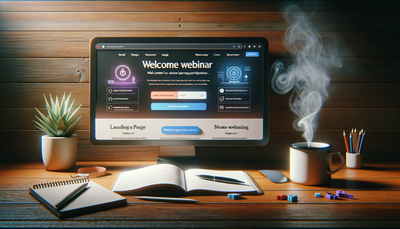Optimizing Landing Pages for Different Traffic Sources
Optimizing landing pages for different traffic sources is crucial for maximizing conversions and improving user experience. By tailoring your landing pages to match the expectations and needs of visitors from various channels, you can increase engagement and drive better results. This article explores strategies for customizing landing pages based on traffic sources such as social media, email marketing, pay-per-click (PPC) advertising, and organic search. We'll delve into the unique characteristics of each traffic source and provide actionable tips to create targeted, high-converting landing pages that resonate with your audience, regardless of where they're coming from.Table of Contents:
-
Understanding the Importance of Tailored Landing Pages
- Optimizing Landing Pages for Social Media Traffic
- Crafting Effective Landing Pages for Email Marketing
- Optimizing Landing Pages for PPC Traffic
- Tailoring Landing Pages for Organic Search Traffic
- Measuring and Improving Landing Page Performance
- Optimizing Landing Pages for Social Media Traffic
- Crafting Effective Landing Pages for Email Marketing
- Optimizing Landing Pages for PPC Traffic
- Tailoring Landing Pages for Organic Search Traffic
- Measuring and Improving Landing Page Performance

Understanding the Importance of Tailored Landing Pages
Creating a one-size-fits-all landing page is no longer sufficient in today's competitive digital landscape. Different traffic sources bring visitors with varying intentions, expectations, and levels of familiarity with your brand. By tailoring your landing pages to these specific audiences, you can significantly improve your conversion rates and overall marketing effectiveness.Customized landing pages allow you to address the unique needs and pain points of visitors from each traffic source. This personalized approach helps build trust, reduces bounce rates, and increases the likelihood of conversions. Moreover, it enables you to maintain message consistency between your marketing campaigns and landing pages, creating a seamless user experience that guides visitors towards your desired action.
Do you need a website? Want to build a website but don't know where to start? Our website builder is the perfect solution. Easy to use, and with the ability to customize to fit your business needs, you can have a professional website in no time.
Optimizing Landing Pages for Social Media Traffic
Social media visitors often arrive at your landing page after engaging with your brand through posts, ads, or recommendations from friends. To optimize for this traffic source, consider the following strategies:1. Maintain visual consistency: Ensure your landing page design and imagery align with your social media presence.
2. Emphasize social proof: Incorporate user-generated content, testimonials, or social media feeds to build trust.
3. Keep it concise: Social media users have short attention spans, so make your message clear and easy to digest.
4. Mobile optimization: Most social media traffic comes from mobile devices, so ensure your landing page is responsive and loads quickly.
5. Include social sharing buttons: Make it easy for visitors to share your content or offers with their networks.
Crafting Effective Landing Pages for Email Marketing
Email marketing traffic often consists of subscribers who are already familiar with your brand. To optimize landing pages for this audience, consider these tactics:1. Maintain message consistency: Ensure your landing page content aligns with the email that brought visitors there.
2. Personalization: Leverage subscriber data to create personalized experiences and offers.
3. Clear call-to-action (CTA): Make your CTA prominent and consistent with the email's promise.
4. Minimize distractions: Remove unnecessary navigation elements to keep visitors focused on the offer.
5. Reinforce benefits: Reiterate the key benefits or value proposition mentioned in the email.
6. Consider multi-step forms: For complex offers, break the conversion process into smaller, more manageable steps.
Building a website with SITE123 is easy
Optimizing Landing Pages for PPC Traffic
Pay-per-click advertising traffic often comes from users actively searching for solutions. To maximize conversions from this source, implement these strategies:1. Keyword relevance: Ensure your landing page content closely matches the keywords used in your PPC ads.
2. Clear value proposition: Highlight your unique selling points and how they solve the visitor's problem.
3. Trust signals: Include trust badges, certifications, and customer testimonials to build credibility.
4. A/B testing: Continuously test different elements of your landing page to improve performance.
5. Fast loading times: Optimize page speed to reduce bounce rates and improve quality scores.
6. Specific offers: Create landing pages for specific ad groups or campaigns to increase relevance.
Tailoring Landing Pages for Organic Search Traffic
Organic search visitors often arrive at your landing page after researching a specific topic or problem. To optimize for this traffic source, consider the following approaches:1. Comprehensive content: Provide in-depth information that addresses the visitor's search intent.
2. SEO optimization: Ensure your landing page is optimized for relevant keywords and follows best SEO practices.
3. Internal linking: Include links to related content or resources to keep visitors engaged on your site.
4. Clear navigation: Make it easy for visitors to explore other relevant pages on your website.
5. Long-form content: Consider creating longer, more detailed landing pages to satisfy informational queries.
6. Featured snippets: Structure your content to increase the chances of appearing in featured snippets on search engine results pages.
Measuring and Improving Landing Page Performance
Regardless of the traffic source, it's crucial to continuously monitor and improve your landing page performance. Implement these strategies to optimize your pages over time:1. Use analytics tools: Track key metrics such as bounce rate, time on page, and conversion rate for each traffic source.
2. Conduct user testing: Gather feedback from real users to identify areas for improvement.
3. Implement heat mapping: Use tools to visualize how visitors interact with your landing pages.
4. Perform regular A/B tests: Continuously test different elements of your landing pages to identify what resonates best with each audience.
5. Monitor competitor landing pages: Stay informed about industry trends and best practices.
6. Regularly update content: Keep your landing pages fresh and relevant to maintain their effectiveness over time.





